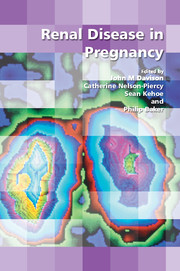Book contents
- Frontmatter
- Contents
- Participants
- Preface
- SECTION 1 RENAL PHYSIOLOGY IN PREGNANCY
- SECTION 2 PATTERNS OF CARE
- SECTION 3 CHRONIC KIDNEY DISEASE
- 6 Pregnancy and dialysis
- 7 Pregnancy and the renal transplant recipient
- 8 Reflux nephropathy in pregnancy
- 9 Lupus and connective tissue disease in pregnancy
- 10 Diabetic nephropathy in pregnancy
- SECTION 4 DRUGS USED IN RENAL DISEASE IN PREGNANCY
- SECTION 5 ACUTE RENAL IMPAIRMENT
- SECTION 6 UROLOGY AND PREGNANCY
- SECTION 7 SURGICAL AND MEDICAL ISSUES SPECIFIC TO RENAL TRANSPLANT PATIENTS
- SECTION 8 CONSENSUS VIEWS
- Index
6 - Pregnancy and dialysis
from SECTION 3 - CHRONIC KIDNEY DISEASE
Published online by Cambridge University Press: 05 September 2014
- Frontmatter
- Contents
- Participants
- Preface
- SECTION 1 RENAL PHYSIOLOGY IN PREGNANCY
- SECTION 2 PATTERNS OF CARE
- SECTION 3 CHRONIC KIDNEY DISEASE
- 6 Pregnancy and dialysis
- 7 Pregnancy and the renal transplant recipient
- 8 Reflux nephropathy in pregnancy
- 9 Lupus and connective tissue disease in pregnancy
- 10 Diabetic nephropathy in pregnancy
- SECTION 4 DRUGS USED IN RENAL DISEASE IN PREGNANCY
- SECTION 5 ACUTE RENAL IMPAIRMENT
- SECTION 6 UROLOGY AND PREGNANCY
- SECTION 7 SURGICAL AND MEDICAL ISSUES SPECIFIC TO RENAL TRANSPLANT PATIENTS
- SECTION 8 CONSENSUS VIEWS
- Index
Summary
Introduction
For women treated by dialysis for end-stage renal disease (ESRD), pregnancy is an uncommon event. Although pregnancy outcomes have improved since the first reported case in 1971, miscarriage, stillbirth, preterm birth and neonatal death remain substantial risks. Strategies (such as ‘enhanced’ dialysis regimens) to improve fetal outcomes are, themselves, not without the potential to cause harm. Furthermore, experience in managing these patients is sporadic. This is reflected in the nature of much of the published literature, which predominantly consists of small case series (incorporating all the potential bias of these) with non-systematic review of other published series. Pregnancy in such women, whether treated by haemodialysis or peritoneal dialysis, thus poses a formidable challenge to renal physicians, obstetricians, neonatologists, dialysis nurses and dieticians.
Incidence of pregnancy
No prospective survey that corrects for patterns of contraception use, sexual activity and other relevant issues on the incidence of pregnancy in women on dialysis has been conducted. Insight is offered from three large studies of variable methodology. A comprehensive national survey in Belgium of 1472 dialysis-treated women of childbearing age reported an incidence of pregnancy (extending beyond the first trimester) of 0.3 per 100 patient-years. A larger survey of 6230 women aged 14—44 years indicated that about 2% became pregnant over a 4 year period. However, this survey was based on responses received from fewer than 50% of all dialysis units in the USA.
- Type
- Chapter
- Information
- Renal Disease in Pregnancy , pp. 61 - 68Publisher: Cambridge University PressPrint publication year: 2008
- 1
- Cited by

